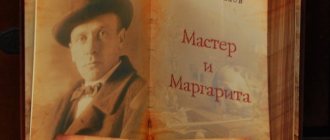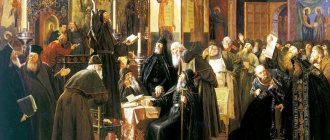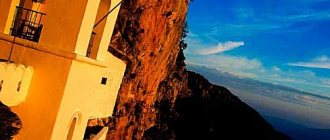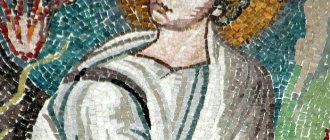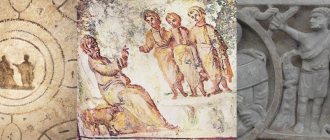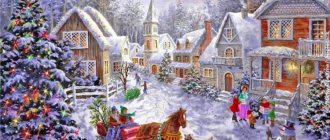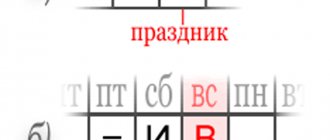When there was no Christmas tree yet
The tradition of decorating the Christmas tree appeared on the Apennine Peninsula in the 19th century. Before this, every family united at Christmas around a small home nativity scene.
It is called the Italian word “presepe” or “presepio” from the Latin “praesaepe” - animal feeder, nursery.
At first it was a miniature image of a Christmas manger. Four other figures depicted Mary and Joseph bending over the Infant Christ, an ox and a donkey kneeling.
Eyewitnesses described the empty rooms of the poor, in which there were only figures from the Nativity scene. They were carved from wood and carved from stone. In different regions of the Apennine Peninsula, terracotta, clay, and papier-mâché were used. The figurines were placed on the festive table or on the fireplace. And in the absence of a fireplace and a table - on the windowsill or on the floor.
Small nativity scene made of coral and ivory, created by Andrea and Alberto Tipa in 1700
And in rich houses, miniature Christmas nativity scenes were fashionable. They were jewelry masterpieces: they were made of gold and silver, coral and pearls, ivory and precious stones.
This technique was especially loved in Sicily: the smallest nativity scenes fit into a thimble; the larger ones are in a matchbox. They could be carried with you in your pocket or on a chain, like an amulet.
Modern nativity scene by Luigi Tramontano. Participant in the competition of the website www.presepio.it
By the 18th century, viewing home nativity scenes was considered top-level entertainment for foreign ambassadors and crowned heads.
In January 1734, a Neapolitan chronicler wrote: “The Vice-Queen, having examined the nativity scenes of our capital, went on Wednesday to see the nativity scene of the royal engineer Desiderio de Bonis... which, with its splendor, the skill of miniature architecture and the grace of the clothes of the dolls, aroused the admiration of the illustrious signora...”
The vice-queen probably spent more than one hour examining the nativity scene: its figurines were stored in dozens of cabinets and occupied several large halls.
Competition entry by Giuseppe Porcelluzzi from the website www.presepio.it. The area of this town has yet to be filled with figures.
Indeed, in the 18th century, new characters were added to the composition of the Christmas manger (actually “presepe”) in Italy: shepherds with sheep and dogs, wise men with camels and black servants, and King Herod with his gloomy soldiers. Other heroes were not listed anywhere except in popular imagination: among them are the shepherd Benino (who is always asleep), the girl Stefania, who dreams of worshiping Christ (and for this she is ready to throw a stone at an angel), the drunkard Cicci Bacco, the owners and visitors of the tavern, which the Holy Family did not allow...
Noon. The Holy Family is resting. Competition entry by Salvatore Maenza Source: website www.presepio.it
In many regions of Italy, Christmas characters of the local tradition appeared: in Bologna - a female figurine, with gestures depicting amazement, even shock, which is called Meraviglia (Surprise).
In Sicily - Dzu Innaru (Uncle January), in the form of an old man who warms himself by a lit fire.
In Tuscany - Gioioso, a boy expressing joy at the sight of a newborn baby.
Modern nativity scene by Nicola Nicolazzo. Source www.presepio.it
Nativity scene created by a modern African artist
Finding themselves next to the Christmas manger (not always on merit), these characters became members of a great community called “presepe”. Reflections of the glory of the Holy Family fell on them too. And the word “nativity scene” began to be applied to all the events of the Christmas mystery that played out in time and space and will continue to play out until the end of time.
What to make a cave out of
The basis of the composition is a cave. Usually depicted as a closed space open on one side.
What can it be made from:
- empty shoe box;
- beautifully draped fabric;
- clay;
- plastic;
- spruce branches installed in the form of a hut;
- basket turned upside down.
You can also glue a paper base and install a wooden fence. An option is to make the background of the nativity scene from cubes or construction sets and drape it with fabric.
Master class in 6 steps
Let's take a shoebox as an example. In addition to this, we will need:
- colored paper (brown, gray);
- sea pebbles;
- scissors;
- glue;
- lentils or beans;
- hay.
- Cut out one of the long walls of the box.
- We crumple several sheets of brown paper and glue the inside of the box without smoothing it out. The result is uneven stone walls.
- On the back wall at the top, first draw and then cut out a star. When the nativity scene is ready and installed in its place, it can be illuminated by placing a burning candle behind it.
- We glue pebbles to the inner and outer walls of the box, often on top, and less often on the inside side walls.
- Cover the floor of the cave with glue and cover it with lentils or beans - you get a structure of stones.
- We throw a handful of hay, small dried flowers and a few more pebbles onto the floor.
If desired, you can decorate the roof and front edges of the box with fir branches, decorate them with garland and tinsel.
Often the top part of the nativity scene is covered with dark blue paper or fabric - the result is a night sky. The star can be cut out of gold foil - this material looks beautiful in the light of the lights of the garland.
Pay special attention to decorating the nativity scene. You can put flowers in pots in front of it. Don't forget about the gifts of the Magi. Don't try to follow the biblical text, the main thing is that the offerings look rich. For example, you can use pearl beads and other jewelry.
At the bottom of the lake
Agostino Finchi's Salt Nativity Scene
There is no substance from which a Christmas nativity scene cannot be made.
Christmas figurines are made from gingerbread, sugar, fruit, and salt crystals (in salt mines). One of these nativity scenes by Agostino Finchi is even on display in the museum.
In December and January, aquariums organize exhibitions of underwater nativity scenes. Underwater Christmas sculptures are created from environmentally friendly sandstone and mounted on iron platforms.
They are installed in shallow water, in the clearest sea or lake water, so that the Nativity scene can be viewed from a bridge or from a high cliff.
Mary and Joseph kneel before an open sea shell containing the infant Christ. Two kind, curious dolphins pointed their noses at the shell.
In the north, on Lake Garda, in December-January, from the San Giovanni bridge near the Peschiera fortress, you can see the characters of the Christmas mystery shining under the night water. Camels, sheep, swaying palm trees and the shining Christmas star are not forgotten.
According to the belief of some regions of Italy, on Christmas Day the water becomes healing. The presence of Nativity scenes on or under water symbolically cleanses bodies of water.
Christmas morning in Rimini (Italy) source: www.patatofriendly.com
In one of the semicircular arches of the ancient bridge of the city of Rimini, worn from antiquity, floats a bright red raft with an image of the Holy Family. In the silence of Christmas morning, only the bare crowns of trees and the white feathers of clouds are reflected in the blue water.
"Winter" in the nativity scene
It is a Russian tradition to make winter nativity scenes. Even if the snow lying everywhere does not correspond to the letter of the Gospel, it looks beautiful and realistic for us.
Snow and snowdrifts can be made from:
- cotton wool;
- salt;
- Sahara.
It's simple. To create “snow” on a spruce branch, you should smear it with glue, sprinkle it generously with salt, add a little glitter and wait until it dries.
It happened in Greccio
Giotto. The Legend of Saint Francis The Miracle of Greccio
Also during the Christmas period, live nativity scenes are organized on the peninsula. A small grotto is erected on the church porch or in the village square. Black and white sheep, roosters, chickens, and shepherd dogs nestle comfortably in the hay. A donkey trumpets in a paddock nearby, demanding attention to his person. In the grotto, Mary rocks a doll depicting the baby Jesus, talks with Joseph and with the angels.
Entire families take part in living nativity scenes, dressing up as wise men or shepherds, Herod's soldiers or the grieving mothers of Bethlehem. Where this tradition is maintained (for example, in the Gargano National Park in the province of Foggia), Christmas performances stretch over half a kilometer in the open air.
When, in 2013, participants in a living nativity scene in Caltanisetta (Sicily) decided to take a photo on the long porch of their cathedral, they had to stand in four rows to get into the frame.
The tradition of live nativity scenes dates back to the time of St. Francis of Assisi. “The Legend of Saint Francis” tells that he, nicknamed “poverello” (“poor man”), brought an ox and a donkey to the Christmas service and placed them in the temple next to a real manger. When the “poor man” began to pray for the birth of the King of the poor, the hearts of the parishioners trembled. Some saw how Saint Francis, during prayer, took the Child Christ from the empty manger into his arms and pressed him to his heart.
It happened on Christmas night 1223 in Greccio (province of Rieti). The miracle at the service in Greccio was depicted in the famous fresco by Giotto. It became the thirteenth fresco among the twenty-eight scenes from the life of St. Francis painted in the upper church of the temple in Assisi (1295-1299). This fresco laid the foundation for the tradition of the Nativity scene associated with the name of St. Francis.
How does the action take place?
The nativity scene is based on the story of the Savior’s coming to earth. An angel announces the birth of God. The Shepherd and three Magi come to worship the Newborn Baby. The latter talk about a meeting with Herod, to whom they informed about the birth of the future great King. The angel warns the Magi not to “go to Herod” and not to betray Christ to him (Herod is afraid that the born King will take away his power). An angry Herod commands the Warrior to “beat the babies” in Bethlehem. Rachel comes to him, begging him not to kill her child: “A voice is heard in Rama, weeping and weeping, and a great cry; Rachel cries for her children and does not want to be comforted, for they are not there” (Jer. 31:15, Matt. 2:18). But Herod is deaf to her pleas. An angel consoles Rachel. Death comes to Herod, he asks her for a reprieve, but Death calls the Devil, and he drags Herod into the underworld.
Theater "Wandering Den"
In the second part of the performance, everyday scenes are shown, then the characters “say goodbye” to the audience.
As Boris Goldovsky, a researcher of the nativity scene tradition, writes, the music in both acts of the performance was no less important than the text. She always gave very accurate characterizations to the characters and filled the performance itself with celebration. Particularly popular were cants, which combined folk songs and secular dance melodies.
The nativity scene has been and remains one of the favorite traditions of celebrating Christmas. And whatever it may be, static, mechanical or even alive, with the participation of human actors, for the viewer it is, first of all, a wonderful sign pointing to that very Bethlehem cave.
With my own hands
Nativity scene made of sand and polystyrene foam from a TV
At the end of the year, many Italians begin to worry about the question: how to make a Christmas nativity scene if there are no funds in the house, but there are skillful hands? Sites that post DIY tips are seeing record numbers of visits in December.
For example, find a styrofoam TV box, a desert wallpaper, a string of light bulbs, and a box of sand. Put all this in front of yourself, watch the video and do as we do.
What if there is no room in the house? Take a crystal glass, put several glass balls in it, a little moss on them, attach miniature figures of the Baby in the manger and the Holy Family on the moss. Place the glass between two candles. Merry Christmas!
Modern nativity scene by Pino Bozzarelli, submitted for a competition on the website www.presepio.it
It's perfectly acceptable to fill your nativity scene with your children's favorite toys. Therefore, at the Christmas nursery there are toy cars, little Santa Clauses, and a variety of toys that also come to worship the Infant Christ. And if a child has a toy car, why don't the Magi drive across the desert in a white toy trailer?
Making your own Christmas nativity scene is one of the most respected arts on the Apennine Peninsula.
The best Christmas nativity scenes are kept in the collections of art museums, folk art museums and private collections. There are even special museums created for them.
The Holy Family on vacation. Detail of another nativity scene by Pino Bozzarelli
Since 1953, the Italian Association of Friends of the Nativity Scene has published the magazine “The Nativity Scene” (Il Presepio). Its members post their work on the site. The authors, who participate in the competition for the best Christmas nativity scene every year, emphasize that they made all the figures with their own hands. “My nativity scene is completely handmade,” says one of the competition participants. Liliana Campo. – It can be deployed 360%. Its dimensions are 30 by 40 by 35 cm. It took 90 days to make it.”
Christmas nativity scene. Infographics
A baby in a nativity scene, as a rule, is a tightly twisted flagellum of white matter; The sheep with which the shepherd comes to worship Christ are a curly ball of yarn. As a rule, the characters in the nativity scene are made of wood or rags, from simple, cheap material - they are easy to make and easy to carry.
However, there was an unwritten rule among nativity scene makers: a doll depicting the Virgin Mary should be made differently than all the others, as if it had been made by another artist. Therefore, the images of the Mother of God and the Savior were created by master nativity scene makers with special care. Sometimes an icon was placed instead of a doll of the Mother of God.
Miracle of Christmas
A competition nativity scene by Joseph Schorra that combines American and Italian traditions. Source www.presepio.it
A small home nativity scene is usually installed in the middle of the living room. It is often placed on a round stand so that children and adults can look at it from all sides. Sometimes it looks like a rocky hill, twisting in a spiral. Shepherds with sheep and dogs, wise men with their gifts, peasants, artisans, robbers, descend or ascend in a spiral. They are watched from above by a golden star and a barefoot angel with huge white wings.
Sometimes the spiral twists along the stairs of dilapidated palaces. It was their ruins that in the 17th and 18th centuries were a refuge for travelers who could not find a place in the hotel. One by one, the Magi ascend to the second floor, dragging their precious robes along the chipped steps. And through the front door a cheerful peddler with a tray is already hurrying after the guests, who is also in a hurry to bring his gifts to the Holy Family. Now others will seep through the door behind him. Some will bring gifts, others will be curious.
Another nativity scene by Joseph Schorra that brings modernity to the heart of tradition.
Soon you will not be able to find the Holy Family in this crowd. But this is the lesson: we do not know how to recognize the heavenly in the earthly.
The story of Christmas appears before us as the story of a community of people who witnessed the most amazing events, but continue to live in everyday life: washing clothes, preparing food, receiving guests. The miracle of Christmas entered the core of their existence, like a shell. Its doors have closed, and the pearl is ripening in silence.
The Savior was born for these people. Therefore, they are the main ones here. The nativity scene in its Italian tradition is a view from above the Christmas star.
Variations
In any nativity scene there will definitely be such characters as the baby Jesus, Joseph and the Virgin Mary. But a lot of details are left to your discretion.
For example, it should be remembered that sometimes it is not a specific moment that is depicted, but a set of events. Usually the worship of shepherds and wise men. Other stories can be seen from time to time.
In Orthodoxy, it is customary to depict a cave, but the option of a hut is allowed, since the environment is not directly specified in the Gospels.
Speaking of characters, if you wish, you can add animals, shepherds, wise men, angels and others.
You can look at a nativity scene from different angles depending on what it is made for. If it is intended to be full-length, for example, in a country house, then you can try to fit it into the existing vegetation. If it is done for a home where this is a strong tradition, then more reliable materials will be preferable so that the structure can be preserved until next year and so on.
Our neighbors in the cave
First depiction of the Nativity in the Catacombs of Priscilla, Rome
People often ask: where is the Christmas cave? For most southern Italian cities, caves - like the one in which the Holy Family took refuge - were as much a fact of life as a clothesline across the street from window to window or a pot of basil on the windowsill.
In Naples, in order to go down to the catacombs, you just need to turn the corner and take the gate keys from the gatekeeper. In the Italian Basilicata, caves are ordinary village dwellings.
Oh, Maria and Giuseppe? Of course we do! They occupied a nearby cave. These are our neighbors across the wall!
A modern nativity scene made by Pino Bozzarelli tells the story of this neighborhood. It contains two parts, enclosed in a wooden frame with the inscription “Per loro non c'era posto...” (“There was no room for them in the hotel”).
On the left is the hotel that could not accommodate the Holy Family on Christmas night. On the ground floor, the housewife feeds the chickens, and her daughter hugs a calf that has just left the nursery. Behind the brick wall is a barn in which the Holy Family found shelter. In the barn, everything looks the same, only more comfortable: hay is drying in the gallery, a tired donkey is happily lying down on the straw, a lantern hanging from a beam is burning... And white doves are sitting in the niches of the windows both here and here.
Nativity scene on the street: beautiful ways to decorate the exterior 2022
The nativity scene looks very atmospheric and cute on the street, illuminating everything around with the magical light of Christmas. In central squares, near houses and shops - this beauty is impossible not to notice! But the most honorable place for a nativity scene is in the temple, near the altar.
The inflatable nativity scene is a source of great delight for both children and adults.
A composition of multi-colored garlands will decorate your yard and will be visible from afar.
Day or night?
Neapolitan nativity scene
In 1707, the Viceroy of Austria, who visited Naples, admired the nativity scene with an unusual lighting system: it allowed the alternation of day and night. The cosmic essence of the Christmas nativity scene is such that after the night the morning must come. And after an alarming sunset, the earth is embraced by a night of peace,
Nativity scene in the Cathedral of the Assumption of the Virgin Mary in Castellammare
The Neapolitan nativity scene must be immersed in darkness. It is illuminated only by the long tail of the Christmas star, cutting through the sky like a curved blade.
A cold winter morning can reign in the den of a Bolognese school: a pale, anxious dawn, the street of a poor Italian town, sheep looking for food among the street stones, kneeling king-magi in golden crowns and mothers with babies who have come to worship the newborn God.
In the nativity scenes from the province of Marche, the mystery of Christmas is played out on a bright day, on a sea pier. Shepherds descend a steep cliff to the azure pier, where the Holy Family took refuge in a boat shed. The boat with the sail deployed is ready to be launched. On the seat is a wicker basket with apples.
How is the nativity scene constructed?
The structure of the nativity scene is very interesting. The box-house, picturesquely decorated on the inside, has special slots for driving dolls. Dolls are not allowed to move from one floor to another. In the upper tier scenes related to the Holy Family were played out, and the lower one depicted the palace of King Herod. In the same part, in later times, satirical sketches and comedies were shown. However, the nativity scene is not just a magic box, it is a small model of the universe: the world above (upper floor), below (lower floor), and hell - the hole where Herod falls through.
Theater "Wandering Den"
In winter, the nativity scene was carried on a sleigh, carried from hut to hut, and performances were shown at inns. Benches were placed around the nativity scene, candles were lit, and the fairy tale began.
The classic “troupe” of the nativity scene is the Mother of God, Joseph, the Angel, the Shepherd, the three Magi Kings, Herod, Rachel, the Soldier, the Devil, Death and the Sexton, whose duty was to light the candles in the nativity scene before the performance. Each doll was attached to a pin, which the puppeteer could grasp from below, like a handle, and move it along special slots in the stage floor.
More information about the structure of the nativity scene:
Sweet taste of details
Bologna. Adoration of the Magi
In 1825, under the king of Naples, Francis 1 of Bourbon, an amazing document was drawn up, which was called “Inventory of all the shepherds, wise men, animals, gifts and provisions of the Royal Den.”
The Christmas nativity scene is not only about the wise men and shepherds. This also includes gifts and food!
The world in which the Holy Family lives is filled with various carts with fruits and flowers, piles of watermelons and melons. The ceiling beams of the houses are bursting with cheeses, sausages, onions, tomatoes in nets, dried vegetables and fruits, snow-white fringes of spaghetti hanging out to dry.
19th century nativity scene in Rome in Piazza di Spagna
The Christmas miracle embodied in the nativity scene is born out of love for every inch of the world around us. Boxes of flowers on a small wooden balcony, a pot on the fireplace, dishes on a shelf, even shovels leaning against the wall - every item should feel like you're in love with it!
Today, in online stores of Christmas figurines you can buy miniature plates with traditional dishes and stands with all kinds of food. For those who create a home nativity scene with their own hands, master classes are announced: what dishes should be “put” in plates in order to maintain the tradition?
Genoa. Fragment of a nativity scene. Sellers of figurines for nativity scenes
Artists so carefully reproduced the details of historical feasts, were so attentive to the details of costumes or to the furnishings of peasant houses of the 18th-20th centuries, that using Christmas nativity scenes it is now possible to study the history of life in a particular region.
The classic 19th-century nativity scene, which is on display in Rome during the Christmas holidays (on the stairs leading to Trinity Church on the Hills), seems like a “time machine”: if you look closely, you can see Roman outfits from the time of Giuseppe Gioachino Belli and his friend Nikolai Gogol: here and the dandy in top hat and romantic cloak, and girls in dresses that could have been worn by the beautiful Annunziata from Gogol’s story “Rome.”
Options for making a nativity scene from scrap materials 2022
When creating a nativity scene, there are no limits to your imagination. pasta, cereals, shells, ice cream sticks and even egg trays when decorating Christmas crafts It turns out very beautiful, creative, and most importantly – environmentally friendly. After all, now more than ever, the popularity of recycling materials is increasing.
Figurines for a nativity scene are a separate creative story that you want to experience again and again, creating the smallest details from plasticine, plaster, clay or felt.
Large nativity scenes are real works of art ; they will become a chic decoration for your home before Christmas. Moreover, you can make this beauty even from ordinary boxes, fir branches and garlands.
Peacocks, cheetahs, monkeys, elephants...
Arnolfo di Cambio. Nativity scene in the Basilica of Santa Maria Maggiore, Rome
One of the first nativity scenes in which the sculptor attempted to depict animals was the “Grotto of the Nativity” by Arnolfo di Cambio (1289) in the Roman Basilica of Santa Maria Maggiore. The attempt was not the most successful: only the heads of the ox and donkey remained. In 1478, the court apothecary of the Duke of Calabria did not share the mistrust of animal depictions. Perhaps the pharmacist had children or grandchildren. But he ordered forty-one figures for his home den, including eleven sheep and two dogs!
In the same 15th century in Europe, peacocks and cheetahs first appeared among the witnesses of Christmas. A dark blue peacock, flying onto the wicker roof of the manger, arches its neck to look at its magnificent tail, folded in a sign of humility, in the famous circular painting “The Adoration of the Magi” (1440-1460) by Fra Filippo Lippi and Fra Beato Angelico.
In the first years of the 15th century, the Limburg brothers depicted on the page of the famous “Luxury Book of Hours” of the Duke of Berry a pair of cheetahs in red collars, sitting trustingly at the feet of the Mother of God. Cheetahs, then called game leopards, were considered the only big cats that could be domesticated. In Europe, kings and dukes hunted with cheetahs (pardus); in Rus' - princes. Cheetahs, as a symbol of the humility of rebellious nature, were brought with them to the Christmas manger by the Magi Kings.
One of the last images of cheetahs as a symbolic animal of Christmas remains the miniatures of the Farnese Book of Hours, made in 1546 by the Croatian artist Giulio Clovio.
Later, in the 17th century, monkeys became guests of the Christmas nativity scene. Then, with an important step, lions and elephants walked towards the manger, which the servants of the Magi Kings brought on leashes from Africa. In Naples, buffaloes played their role in the mysteries of Christmas, from whose milk mozzarella cheese was already made.
Nativity scene of the Bolognese school
In the 18th century, among the craftsmen who made sculptures for Neapolitan nativity scenes, the brothers Nicola and Saverio Vassallo were famous: Saverio liked to make figurines of goats and sheep. Nikola carved camels, dogs, mules, bulls and even piglets from wood.
By the way, modern creators of nativity scenes from time to time release a pink pig into the Christmas world, which trustingly moves its snout, in the hope that it will not be made into sausages for the holiday.
Nativity scene: art born of faith
In Europe, to this day, there is a centuries-old tradition of setting up a nativity scene in the house at Christmas. Some people buy it in a store or at a fair, others prefer to make it themselves. In Russia, nativity scenes were popular before the revolution. Since 1917, when anti-religious propaganda began, the traditions and rituals associated specifically with Christmas were the first to come under attack. The revival of the nativity scene occurred in the 1980s. Ideological pressure weakened, and folklorists had the opportunity to openly and actively study traditional folk and religious culture. Over the past twenty years, the revived nativity drama has enjoyed wide popularity.
It is staged by professionals and amateurs, on the big stage and at home for the benefit of their families. However, there is a difference between nativity scene and nativity scene... What is a nativity scene? Nativity scene (vrtпъ) translated from Old Church Slavonic means cave. And although the word has many other meanings, as a rule, it refers to the only cave in which Christ was born. The Cave of the Nativity, or Holy Nativity Scene, is located under the pulpit of the Church of the Nativity in Bethlehem. The Savior's birthplace is marked on the floor with a silver star and an inscription in Latin: “Here was born Jesus Christ of the Virgin Mary.” Sixteen lamps glow in a semicircular niche above the star. And a little further away is the chapel of the manger - the place where the Virgin Mary laid Christ after birth. The Manger itself - a feeding trough for domestic animals, which the Virgin Mary used as a cradle, was taken to Rome in the 7th century as a great shrine. And the niche where the manger once stood was lined with marble. This Nativity scene became the prototype for subsequent nativity scenes created by human art. Time passed, and from the hands of the craftsmen began to come out carved wooden nativity scenes, made of cardboard and papier-mâché, clay, porcelain, plaster... Refined and simple, large and small panoramas, reproducing the scene of the Birth of the Savior to the world, were a kind of Bible for the illiterate. Some scientists attribute the appearance of such panoramas to Francis of Assisi, who celebrated the holy night in the village of Greccio in 1223. To remind of the holiday, he created a living, as we would say now, installation of a nativity scene (in Italian - “presepe”, “nursery”). Since then, in Italy there has been a tradition of installing presepe in churches and houses of believers. In 2005, an exhibition of Italian presepe was held in Moscow, in the Cathedral of Christ the Savior. Nativity scenes were brought here from all regions of modern Italy. The images of the infant Christ and the Virgin Mary, Joseph, angels, and shepherds in these static compositions often transport the viewer from ancient Judea to modern Italy with its picturesque streets and colorful inhabitants. By the way, in Naples there is a street on which numerous nativity workshops are still located. In Russia, of course, presepe also took place. In churches to this day, a small tent of fir branches is built over the Nativity icon, often decorated with shiny tinsel. However, more popular (especially in the 18th-19th centuries) were theatrical nativity scenes - short puppet shows with a Christmas plot. Nativity scenes were also called wooden two-story portable boxes-houses, where, in fact, the performance was performed. But no matter what the nativity scene is - static, mechanical, living - for the viewer it remains a wonderful sign pointing to that very Bethlehem cave.
Nativity scene by V. Novatsky
History of the nativity scene As Boris Goldovsky writes in his “Essay on the history of the nativity scene in Russia,” the nativity scene is one of the most mysterious theatrical and aesthetic phenomena that reflected the ideas of world order characteristic of different eras.
Even the ancient Hellenes knew something similar. A board was installed on the column, on which scenes were shown, changing when the curtains were closed. A two-story box, similar to a nativity scene, was described in the 1st century. n. e. mechanic Heron of Alexandria, the dolls in it were mechanical, set in motion using a special handle. The gods were in the upper floor, the Argonauts were in the lower floor. If we talk about Christmas scenes, then, according to Boris Goldovsky, they appeared much earlier than 1223, around the 5th century, during the time of Pope Sixtus III. The latter reasonably reasoned that the most direct way to the hearts of ordinary people who knew neither ancient Greek nor Latin was a visual illustration of a biblical story. Around that time, voluminous panoramas of the Bethlehem Nativity scene with a baby in a manger and animals bending over him began to appear in churches. According to some scientists, the nativity scene came to Rus' with the adoption of Christianity and, most likely, was a panorama. Nevertheless, the first reliable information about the existence of nativity scenes dates back to the end of the 16th century. On the territory of the Russian Empire, a den box with a manufacturing date of 1591 was discovered. Theater "Wandering Den"
By the 17th century, mechanical nativity scenes became popular throughout Europe and, of course, in Russia. Moreover, the Christmas drama was shown not only in secular houses, but also in the houses of priests. And by the end of the 18th century, a dynasty of nativity scene performers had formed in St. Petersburg - the Kolosov family, who for almost a whole century kept the traditions of performing performances. The heyday of nativity scenes came in the 19th century, when they became popular not only in central Russia, but also in Siberia. True, sometimes local bishops banned nativity scenes, fearing Catholic influence. But since the nativity scene became more of a folk performance, and, as a result, an uncensored, traditional Christmas entertainment, such orders were of little help. Until the end of the 19th century. The nativity scene wandered through cities and villages, at the same time experiencing “secularization” and turning from a puppet drama with a plot from Sacred History into a secular folk performance. The nativity scene began to consist of two parts: a Christmas mystery and a cheerful musical comedy with local flavor. But by the end of the century, the farcical scenes played on the lower floor turned out to be more significant than the events of the “upper tier.” The nativity scene makers began to carry the wonderful box to fairs, not only on Christmastide, but they went with it right up to Maslenitsa. It is known that some artists even went with nativity scenes to the Nizhny Novgorod Fair. By the way, the “instructor for all Russian trade” opened on July 15! The October Revolution of 1917 and the anti-religious campaign that followed it decided the fate of Christmas performances. They, like the traditional Christmas tree, were strictly prohibited. Soon the texts of nativity plays were lost and the secrets of driving dolls were forgotten. Only in 1980, the Folklore Ensemble of Dmitry Pokrovsky devoted its activities to the restoration of the traditional nativity scene. Pokrovsky turned for help to the famous puppet theater researcher, director Viktor Novatsky. The folklorist studied Belarusian, Ukrainian and Russian nativity scenes, carefully examined the nativity boxes in the Sergei Obraztsov Theater and in the Bakhrushin Museum. Collecting bits and pieces, identifying characteristic features, Novatsky restored the text of the performance and “revitalized” the Christmas dolls. His version of the action has become a classic example. Novatsky figured out some of the simple tricks of the nativity scene. For example, how do the Magi kneel before the Child? (As it turned out, the chick from which the sorcerer was made was shorter than the drapery he was wearing.) How does Herod’s head fly off his shoulders when Death cuts it off with a scythe? (Herod’s doll was not made from a single piece of wood. The head was attached to a pin by which the character was led. Pull the pin down a little and the head would be removed!)
Angel.
Nativity scene by V. Novatsky How is the nativity scene constructed? A nativity scene is a two-story box-house with slots for driving dolls, which, according to tradition, is picturesquely decorated on the inside.
Dolls are not allowed to move from one floor to another. In the upper tier scenes related to the holy family were played out, and the lower one depicted the palace of King Herod. In the same part, in later times, satirical sketches and comedies were shown. However, the nativity scene is not just a magic box, it is a small model of the universe: the world above (upper floor), below (lower floor), and hell - the hole where Herod falls through. In winter, the nativity scene was carried on a sleigh, carried from hut to hut, and performances were shown at inns. Benches were placed around the nativity scene and candles were lit. The fairy tale began. The classic “troupe” of the nativity scene is the Mother of God, Joseph, the Angel, the Shepherd, the three Magi Kings, Herod, Rachel, the Soldier, the Devil, Death and the Sexton, whose duty was to light the candles in the nativity scene before the performance. A baby in a nativity scene, as a rule, is a tightly twisted flagellum of white matter; The sheep with which the shepherd comes to worship Christ are a curly ball of yarn. As a rule, the characters in the nativity scene are made of wood or rags, from simple, cheap material - easy to make and easy to carry. However, there was an unwritten rule among nativity scene makers: a doll depicting the Virgin Mary should be made differently than all the others, as if it had been made by another artist. Therefore, the images of the Mother of God and the Savior were created by master nativity scene makers with special care; in them, the latter strictly focused on icons, sometimes placing an icon instead of a doll of the Mother of God. Theater "Wandering Den"
How does the action take place? The nativity scene is based on a story telling about the coming of the Savior to earth. An angel announces the birth of God. The Shepherd and three Magi come to worship the newborn Baby, telling about their meeting with Herod, to whom they informed about the birth of the future great King. An angel warns the Magi not to “go to Herod” (he is afraid that the born King will take away his power). An angry Herod commands the Warrior to “beat the babies” in Bethlehem. Rachel comes to Herod, begging him not to kill her child: A voice is heard in Rama, weeping and sobbing, and a great cry; Rachel cries for her children and does not want to be consoled, for they are not there (Jeremiah 31:15 , Matthew 2:18 ). An angel consoles Rachel. Death comes to Herod, he asks her for a reprieve, but Death calls the Devil, and he drags Herod into the underworld. In the second part of the performance, everyday scenes are shown, then the characters “say goodbye” to the audience. As Goldovsky writes, the music in both acts of the performance was no less important than the text. She always gave very accurate characterizations to the characters and filled the performance itself with celebration. Particularly popular were cants, which combined folk songs and secular dance melodies.
Rachel.
Nativity scene of V. Novatsky Where to see? In the very center of Moscow, on Varvarka, there is the Doll's House .
This is actually a home in which the dolls feel free. They sit, lie down, fly, dance and drink tea, play musical instruments - in a word, they live wherever they want and comfortably, without being constrained by the glass of a display case. The Puppet Museum was opened in 1992 by Olga Okudzhava, who gathered a very diverse population in her “House”: dolls from antique to antique, from store-bought to original, as well as doll-artists who from time to time play small performances for museum visitors. It is to the last family—theatrical dolls—that nativity scenes heroes belong. The tradition of celebrating New Year and Christmas evenings in the “Doll House” has been around for more than 15 years. The museum houses one of Viktor Novatsky’s nativity scenes and a huge suitcase in which the puppet characters are stored until Christmas. After all, Novatsky’s nativity scene is more than a museum exhibit. Every year, the Christmas performance is performed by folklorist students, married couple Vladimir Ploskikh and Natalya Markova. Chantly, like a church prayer, they tell the Bible story to the children. As museum employee Natalya Zhavoronkova says, more than two actors will not be able to control the puppets, because the theater is tiny. Although in the old days it happened that the whole family took part in the performance: the father controlled the puppets, the mother sang along, and the children created noise effects. And although the museum is relatively young, many of its visitors, as Natalya says, grew up watching these performances. They came for the first time as small children and were so impressed that they watch the nativity scene year after year. Even when they grow up, they are not disappointed. Of course, someone may object: would an adult believe a doll? But Natalya is sure that the secret of the nativity scene is that it is not an ordinary puppet theater. “It’s impossible to say for whom the Christmas performance is being played out - for children or for adults,” says the guide. - It is universal. Both of them watch him in fascination. And although the drama lasts for 15-20 minutes at most, those in the audience feel as if they were watching a full-fledged performance, and not a short Christmas scene. And the nativity scene attracts not only church-going children. Quite the contrary, most of our viewers are people far from the church. We often invite orphanage residents to performances,” says Natalya. “One day a mother and child came to us, who, not only about the nativity scene, had very vague ideas about the Nativity of Christ. For them, this performance was a real discovery. And again the family came to us exactly a year later.” Photo by Vladimir ESHTOKIN The editors would like to thank the Doll's House Museum for their assistance in preparing the material.
LINDE Julia
https://www.foma.ru/article/index.php?news=5030
Nativity scene with toy figures
Surely in every home there are small toys in the shape of animals and dolls representing people of a suitable size.
They can be used in a composition. This simplest craft option is also available to kids; together with their parents, they can choose suitable figures and find a place for them in the cave.



